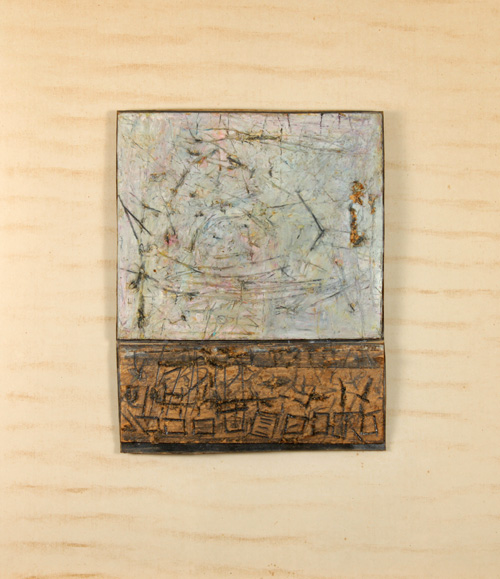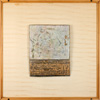< Back to Paintings
< Previous Next >
Mirit Cohen - Panda & Pencil on Wooden Cardboard - Message to the Public
מירית כהן - פנדה ועיפרון על קרטון ועץ - הודעה לציבור
If I should have attempted to draw Mirit Cohen and give a visual metaphor to the overall impression she left on my mind, I would have drawn a torch. It wouldn't be an Olympic torch with a big dancing yellow flame that emits a strong light and a lot of smoke, but rather a hot red glowing torch that steadily consumes itself. Mirit's look was directed inwardly, but it was so intense and total that some of it had to leak out and diffuse back to the outer world.
הזיכרון שלי ממירית כהן (1945-1990) אינו מכיל רק מראות או משפטים קונקרטיים אלא בעיקר רושם כולל שאם הייתי צריך לצייר אותו הייתי מצייר לפיד. לא לפיד עם להבה גדולה וצהובה שרוקדת בקצהו ומפיצה אור ועשן סביב אלא לפיד שקורן אור אדום נמוך כגחלת שמאכלת את עצמה באיטיות. המבט של מירית הופנה פנימה אל תוך עצמה, אבל העוצמה והריכוז היו כה גבוהים עד שהאלומה נהרה החוצה, כאור עמום אדום.
מירית הייתה אמן אולטימטיבי - זה שמדבר רק עם עצמו ומתעלם לחלוטין מן הרגע שאולי יגיע, אי שם בעתיד, ובו ינוח מבטו של מישהו על מה שצייר. היכולת ליצור משהו בשביל אחרים מבלי לחשוב עליהם, מבלי להיות מושפע מהכרת טעמם, מהבנת יכולותיהם ואולי אף מעצם הידיעה על קיומם של צופים, היא בגדר חירות נפלאה שמובילה ליצירות שנסיון למצוא בהן צורה מוגדרת, מציאות קונקרטית או בדל מטפורה, מועד מראש לכישלון. אי התייחסות לצופה היא התרסה קשה שמחירה עלול להיות גבוה אך מצד שני היא מאפשרת לאמן להוציא החוצה ללא עכבות את העוצמה והאינטנסיביות של התהליך האניגמטי הפנימי שרוחש בתוכו. מירית כהן מתעלמת מן הצופה אבל לא מאפשרת לו להתעלם ממנה.

Panda Painting by Mirit Cohen - A Message to the Public
![]()
Mirit Cohen - Panda & Pencil Carving on Wooden Cardboard - A Message to the Public
ציור הפנדה החרוט בעפרון שלפנינו מחולק לשני משטחים מלבניים. העליון מבין השניים, שהוא גם גדול יותר ובהיר יותר, קרוב בממדיו לריבוע. הרבה מאוד דברים "קורים" בו. בגלל בהירותו הוא מזמין התעמקות ובחינה של שפע הפרטים שיש לו להציע - שלל קוים וסימנים מסוגים שונים, שחלקם עשוי להזכיר אותיות ומספרים למי שרגיל או מעוניין לחפש את מופעיהם של המציינים התרבותיים האלה. אבל, עד כמה שאני לא מתבונן בריבוע הזה וסופג את פרטיו לתוכי, אני מרגיש שהשלם נחבא היטב מאחורי חלקיו, צועק על נוכחותו אך מעלים את זהותו. יש כאן שימוש מאוד מתוחכם ועשיר בגוני הצבע השונים ומה שבמבט ראשוני נראה כמו "לבן מלוכלך", מתפרק להרבה גוונים ונגיעות צבע מאוד קטנות ועדינות, נגיעות וורודות, רבות מיני ספור.
ומה לגבי החלק השני של הציור? החלק התחתון שצורתו כמלבן צר וארוך, ומשטחו חרוץ בצפיפות בקוים שחורים ובשנתות חרוטות בחום העץ הבהיר? שפע צורות, שמצד אחד הן מוגדרות ביתר חדות ובהירות מאשר בחלק העליון ומצד שני הן אניגמטיות לא פחות ואינן מספקות רמז על המסר ועל משמעות ההודעה שאותה כותבת הציירת.
יש הבדל מהותי בין התחושות שמעוררים בי שני חלקי הציור. הריבוע הלבן העליון מעורר תחושה של תוכן מובן אך לא של הודעה. אנחנו מתבוננים בו כמי שקיבלו אישור להקשיב לשיחה אבל לא ליטול בה חלק פעיל - המשוחחים שקועים בשיחתם ואינם מתיחסים לצופה שעומד בקרבת מקום ומקשיב להם. לעומת זאת, המלבן התחתון מציג לנו הודעה שאינה מובנת. הטקסט כתוב בהירוגליפים. הוא דן במשהו וכל מי שמתבונן בו הוא נמען פוטנציאלי. יש מסר, אבל כדי להבין אותו צריך לפענח את הכתב וזה תנאי כלל וכלל לא פשוט. אני מוכן להסתכן ולומר שאיש לא יצליח לפענח את הכתב ולקרוא את הטקסט. בכל זאת, האם ניתן לדעת במה עוסק הטקסט שבמלבן התחתון, למרות שלא ניתן לפענח את הכתב ולקרוא בו? אני סבור שכן - ההודעה עוסקת במה שמתרחש בריבוע העליון, ומתארת בכמה משפטים חרוצים ונחרצים, את הדרמה שקורית שם. אין ספק שמדובר פה בטקסט עוצמתי במיוחד שכל מלה בו נבחרה בקפידה. מירית כהן היתה אדם עוצמתי, הן בחיי הרגש שלה והן באינטנסיביות של חשיבתה הרציונלית. היא רצתה לנתח ולהבין את מה שקורה לה ולייצג על גבי הבד את ההתבוננות השכלתנית שלה בבתוך תוכה מבלי לשתף אותנו בפרטים מיותרים. אני חושב שהיא הצליחה.
As I perceive it, Mirit was the ultimate artist - a person that holds a very serious, everything on the table, dialog with her self. A person that completely ignores the possibility that at some point in the future an eye that is not her own will rest upon her work. The ability to create something which is primarily intended for others to look at, yet to work in a state of total ignorance to the existence of these external observers, is synonym in my mind with true artistic freedom. It results in works of art which are particularly enigmatic. Trying to find in them familiar objects, concrete pieces of reality, landscapes, faces, easy to understand hints and metaphors, will prove fruitless. Ignoring the presence of a spectator is a grave defiance for which the artist may be required to pay a high price but on the other hand, such works are not without content. To the contrary. They reflect the enigmatic process which gave them birth. They ignore the spectator but they do not allow the spectator to ignore them.

Mirit Cohen signature in Hebrew on the upper right corner of the lower panel of the painting
This panda painting is divided into two rectangular panels. I'll start with the upper one which is the bigger, almost a perfect square and employs lighter colors. Its brightness invites us to have a close examination of the plethora of details it has to offer - various lines and marks of all kinds - which may look to the eye of the one who is in the habit of looking for such signs, as letters or numerals or other recognizable graphics. However, I find that no matter how much effort I put into looking at it and studying the details, the whole is well hidden behind its parts. It declares its presence but conceals its identity. Note the sophisticated use of colors. The big square which looks at first glance as though it is covered with uninteresting "dirty white", uncovers a very rich pattern of colorful touches and delicate tones and sub tones with many pinks scattered everywhere. The fact that I cannot attach a story or a coherent interpretation to this beautiful complex composition does not prevent me from enjoying or admiring it.
And what about the other part of the painting, the lower panel which is much narrower compared to its length and densely covered with deep dark lines, carved in the surface against a light brown wooden background? Once again I am facing this wealth of symbols which look much more sharply defined than the forms appearing in the upper part, but, nevertheless, not less enigmatical and avoiding any clear hint about their possible meaning. However, I find that there is an essential difference between the two parts of the painting. The upper part conveys the feeling that it carries a meaning but not a message. It doesn't attempt, so to speak, to say anything to us. We look at it as though someone had admitted us to his saloon but forbade us to take part in the conversation. The people who do take part in the conversation are completely ignoring the presence of the silent bystanders. Contrary to that, the lower rectangle is about text. It conveys a message, and any onlooker is a potential addressee. There is a meaning behind the text, but in order to get to it you have to decipher the text. This is the catch. The text is written in hieroglyphs, which are, with an almost hundred percent certainty, undecipherable.
Nevertheless, can we at least make a guess about the subject matter of the text in the lower rectangle, although we cannot decipher it? I volunteer to make such a guess. I think that the message refers to the things that go on the upper part of the painting. I think that it explains the drama that takes place in the upper part in a few, well thought of, sentences. It clarifies the drama and makes sense of it. Mirit Cohen was a powerful person, both in her emotional inner life and in her capabilities of rational thinking. She wanted to analyze and understand the things that she saw when looking into herself. She also wanted to represent in her art this process of rational examination of the emotional life, with no obscuring effects caused by details. I believe that she was very successful in achieving this aim.
אני אוהבת אמנות מורכבת, מקסימליסטית, לא מינימליסטית ולא פורמליסטית בנקודת המוצא שלה. בדרך כלל אני לומדת בדרך השלילה. כך ציטט האוצר יהושע נוישטיין מפי מירית בהקדמתו לקטלוג התערוכה הרטרוספקטיבית שהציגה את עבודותיה של מירית כהן במוזיאון ישראל ב-1994.
לומדת בדרך השלילה. כנראה שכן. עד הסוף.
Biography of the painter Mirit Cohen - ביוגרפיה של הציירת מירית כהן
היצירה "הודעה לציבור" שלפנינו הושלמה ע"י מירית ב-1971 והוצגה בתערוכת היחיד הראשונה שלה בגלריה דוגית בת"א. מירית מיסגרה את הציור הזה במו ידיה, כפי שעשתה במרבית עבודותיה מראשית שנות השבעים. ברוב המקרים השיקול היה תקציבי בעיקרו אך במקרה זה נראה שמירית כיוונה אל השלם - לוח הקרטון והעץ שעליו צוייר הציור, הודבק במרכזו של גליון רקע שעליו ציירה מירית אדוות גלים חומות ופסטורליות - תבנית השקט שנושאת את הסערה.
Size of painting (central board): 9.8" x
1' 0.6" - 25 cm x 32 cm - 9.8 in x 12.6 in
Size of painting (with background): 2' 0.4" x
2' 0.4" - 62 cm x 62 cm - 24.4 in x 24.4 in
Type of frame: Wood & glass - originally framed by the artist
Painting technique: Pastel Panda and Pencil painting and carving on
wooden cardboard
Origin: Israel
Date: 1971
Signature: "מירית" signed by the artist in Hebrew on the upper
right corner of the lower panel of the painting.
Price: Call
References:
Biography of Mirit Cohen - A Fierce and Unerring Artist
© Dan Levy - Art Pane Home of Original Paintings and Sculptures
< Back to Paintings
< Previous Next >

